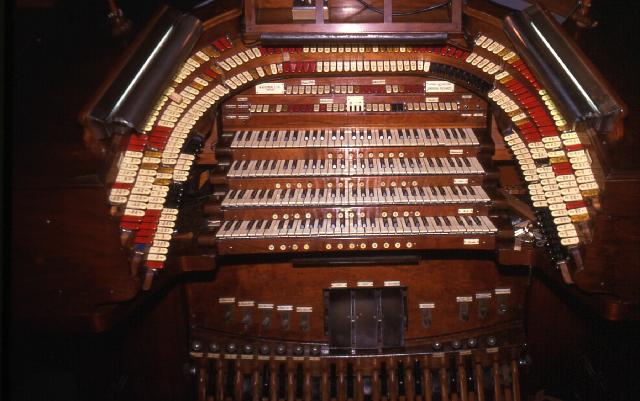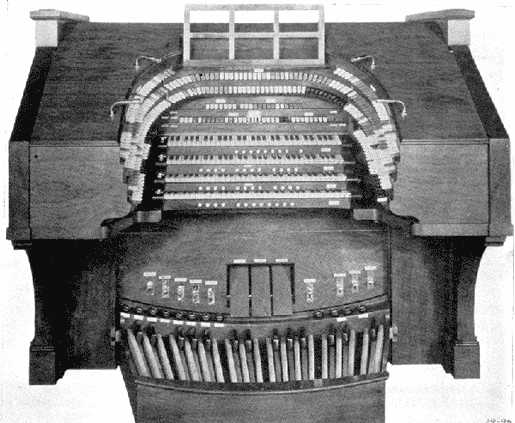The Ballroom Organ ...

These photos courtesy of Charles Swisher





Thus it is actually larger than the Rockefeller Center Music Hall, and nearly twice the size of the new Symphony Hall in Lincoln Center. Despite its size it is acoustically better than either one.
It faces the Boardwalk and the ocean and has a large stage at the front of the Room. The organ is cited in two chambers, one on each side of the stage. The console is located on a balcony half way along the inner side of the Room about 110 feet from the nearest chamber and about 150 feet from the left chamber, (facing the stage). From the console the organist has a clear view of the Room and hears both sides of the organ equally well.
The Ballroom organ has a proper ensemble of Chorus diapasons and reeds, in both chambers. These choruses consist of 20 voices up to mixtures. These voices are never found in the theater organ.
The organ architect, the late Emerson Richards, imposed 22 voices of unit character consisting of flutes, strings, and reeds, all of orchestral character. Because of this combined character this organ is much larger, both in number of pipes and decible output than any theater organ ever built and the console is also larger in the number of stop controls than any similar organ.
Four manual and pedal conventional circular type console, controlling 55 ranks (over 4,000 pipes) disposed in two chambers located on either side of the ballroom stage. With a total of 637 hand operated and 52 foot operated items, a concert of the classics, the solemnity of a liturgical service or the tempos of modem orchestration can be performed on this pipe organ.
It was the intention of Mr. Lincoln Dickey, the first manager of the Hall to use this room as a dance hall and also as a motion picture theater. Therefore, he wanted an organ of orchestral type, or as he viewed it, a theater organ. Mr. Richards, who also designed this organ, was unwilling to design the organ for the limited purpose of accom- panying motion pictures, something that sound pictures was soon to displace and therefore designed an all purpose organ that would be orchestral in character but would likewise have the foundation of a true organ. The result was again a pioneer organ that as events developed, has proved adequate for all the purposes to which the room is now used. The room is now an auxiliary hall for the use of small conventions, large dinners, and Social affairs. For these purposes the organ serves very effectively.
The organ is powerful enough to fill the Hall on all occasions and at the same time is itself a very beautiful instrument. Mr. Richards departed from usual theater organ design which consists in employing a total of from 8 to 15 "units" of orchestral reeds, flutes, strings, and diaphones all on high wind pressure. These "units" are spread over several manuals at the same and different pitches to give the impression of large size and power.
In the case of the Ballroom organ the organ architect first gave the organ a proper ensemble of Chorus diapasons and reeds, in both chambers. These choruses consist of 20 voices up to mixtures. These voices are never found in the theater organ. Then upon this foundation Mr. Richards imposed 22 voices of unit character consisting of flutes, strings, and reeds all of orchestral character. The combination proved to be an outstanding success and in organ of solid but brilliant character resulted, Because of this combined character this organ is much larger, both in number of pipes and decible output than any theater orqan ever built and the console is also larger in the number of stop controls than any similar organ.
The organ was built by W. W. Kimball Company of Chicago, Illinois and was compleled in 1931. It was voiced under the personal direction of its designer, Mr. Richards.
TheatreOrgans.com operates KEZL-FM Culbertson, NE A Non Profit Full Powered Radio Station